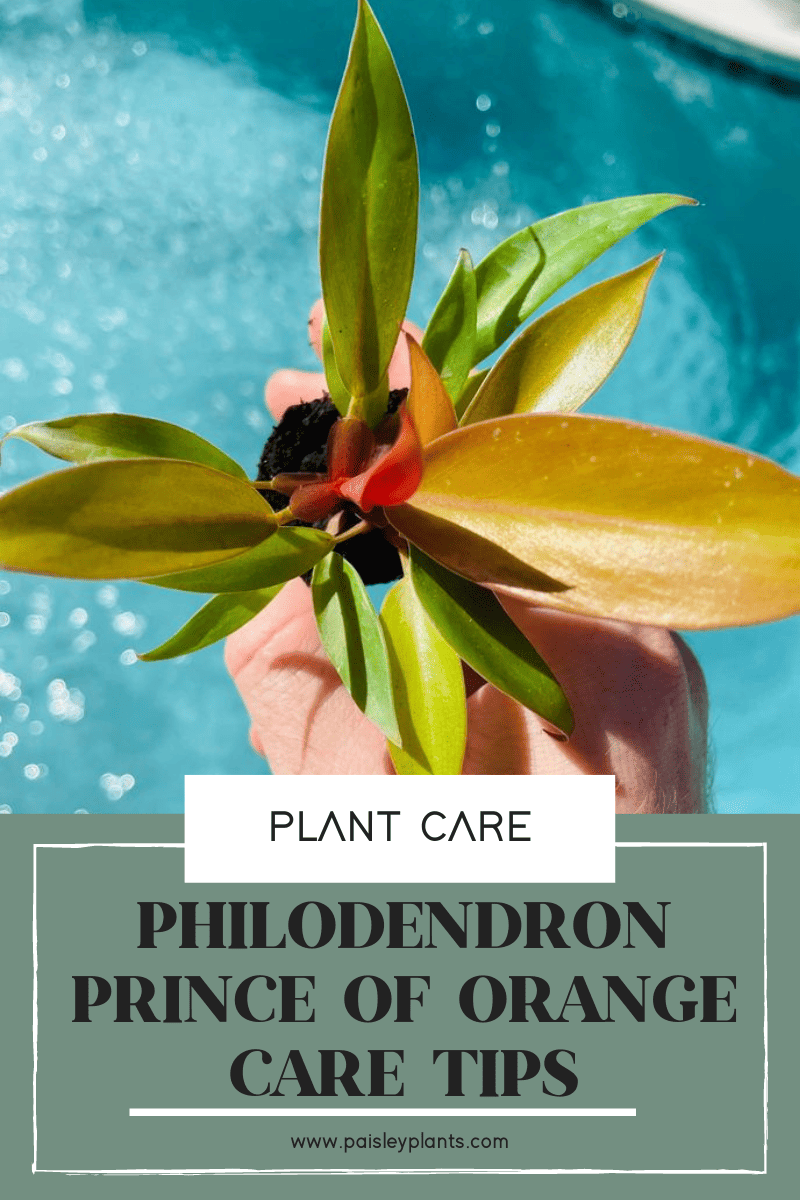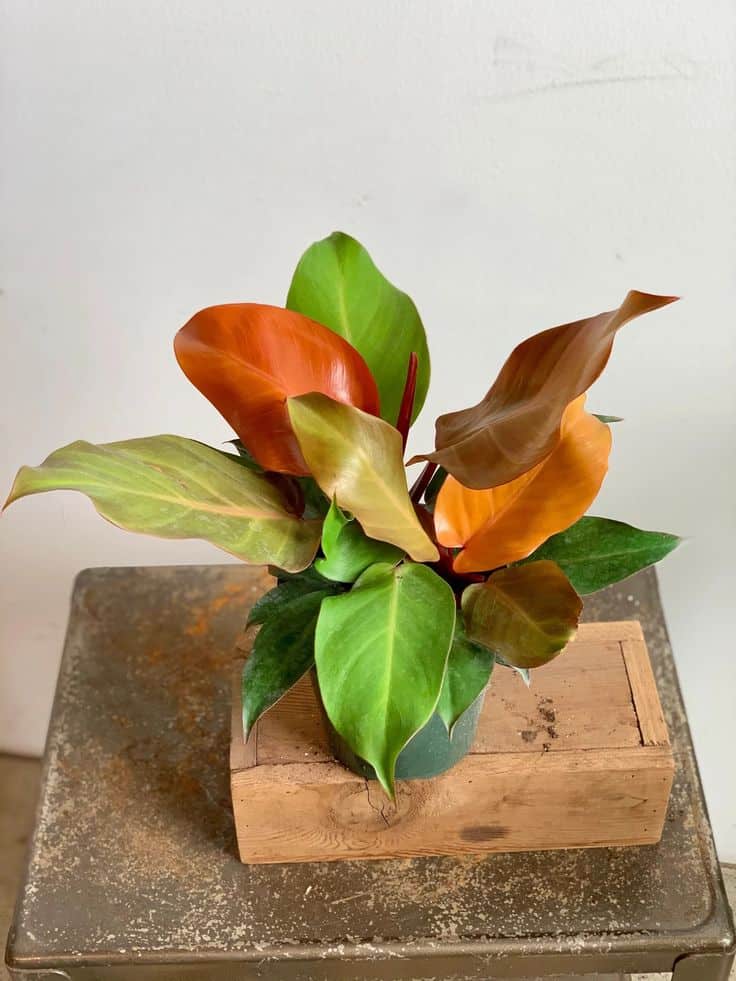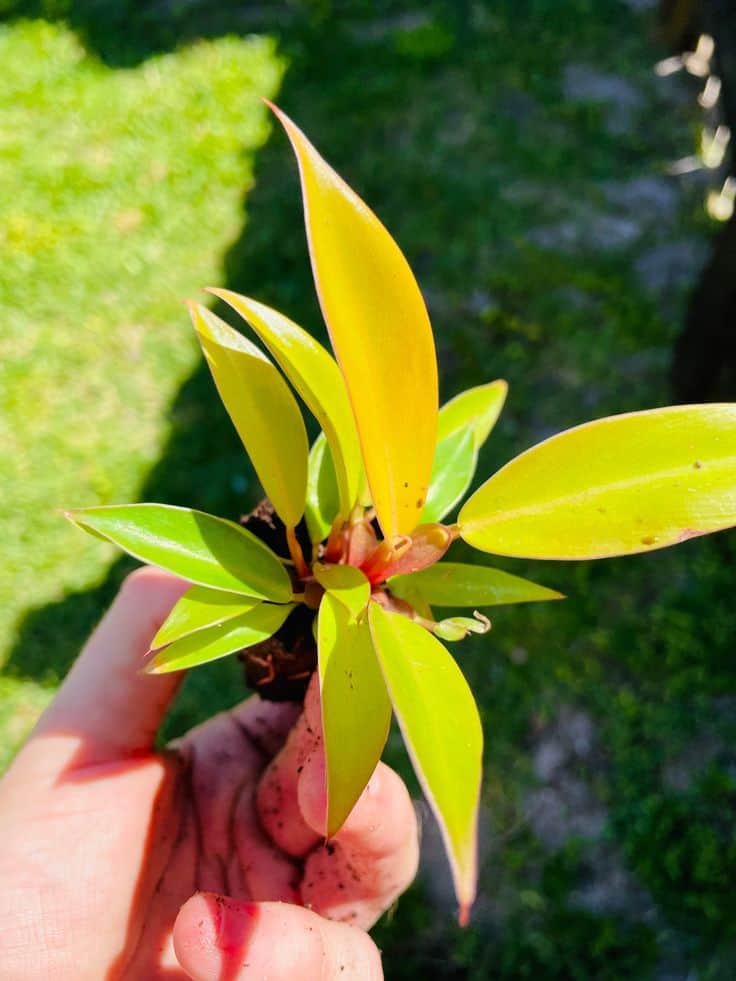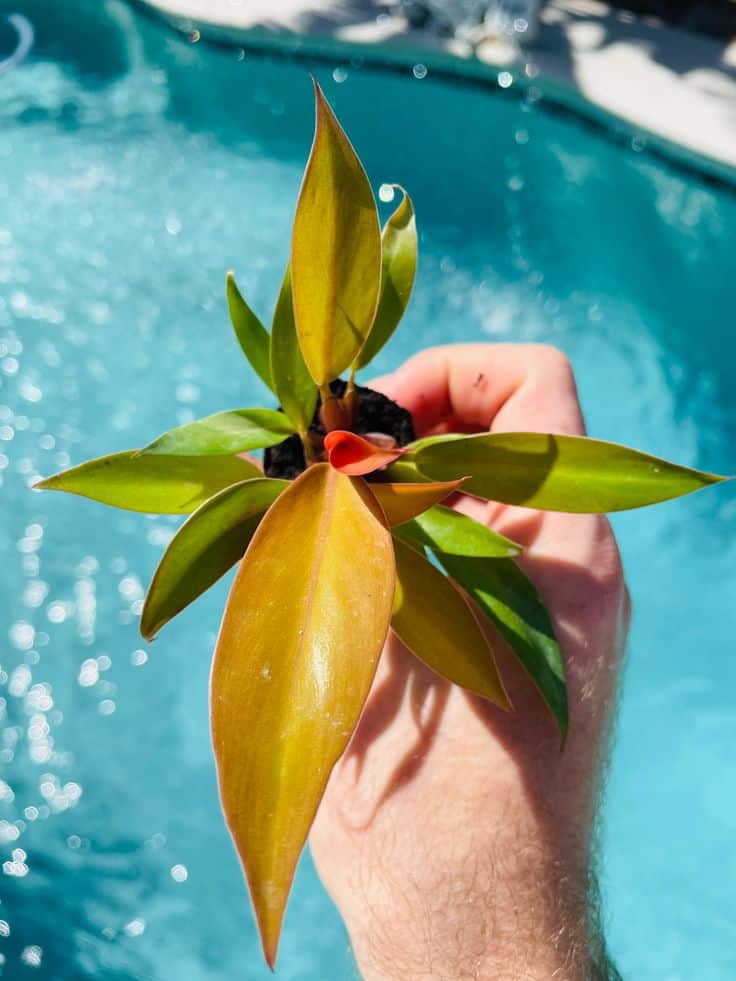If you’re not familiar with the Philodendron Prince of Orange plant, then join the club! It is a relatively rare type of philodendron, but is becoming more and more common amongst houseplant owners.
Let’s take a look at some of its unique characteristics and learn about how to care for one of these beauties!
Table of Contents
Background and History
Did you know that the Philodendron Prince of Orange has never grown in the wild? It was first introduced and patented in 1989 as a modern hybrid in a greenhouse.
It has all the main characteristics of its wild philodendron ancestors, which are native to the tropical rainforests of the Caribbean and Central and South America.
Propagation
Prince of Orange plants are fairly easy to propagate as well! You can either take stem cuttings and put them in soil or water (cut them just below their nodes).

Common Names
Sometimes also called the Orange Prince, the name Prince of Orange Philodendron gives a pretty good description of the color changing leaves which grow from a central stem in the center of the plant. The new leaves first emerge a shade of neon yellow then turn orange. How cool is that?
And, did you know that the large leaves will eventually turn a pale green once they mature? The different colors this plant displays over time are very interesting to watch and also can add new dimensions to your decor.
Varieties
The Philodendron Prince of Orange is a specific variety of the philodendron species. There are some similar Philodendron varieties of this plant like the Prince Albert philodendron, but each one has specific characteristics (like their leaf markings) that make them special.
Toxicity
The Prince of Orange plant is toxic to both humans and animals. The plant contains calcium oxalate crystals which are found in all parts of the plant, including the sap and are toxic if ingested. It is best to keep these plants away from your pets and small children!
Philodendron Prince of Orange Care
The Philodendron Prince of Orange is a relatively easy to care for plant. Here’s everything you need to know about growing one in your home!

Image via Sunshine Greens
Watering Requirements
Because your Prince of Orange is a tropical plant, it will need to be kept watered consistently. You should use tepid water, not cold water when watering it.
The soil should remain moist, but not soaking wet. Leaving the soil soggy can suffocate the roots and lead to root rot. Be sure to use a pot with a drainage hole at the bottom of the pot so excess water can get out.
If you’re unsure if your plant needs water, stick your finger into the top few inches of soil. If it’s wet, don’t water it. If it’s dry, you can give it water!
Light Requirements
Your Prince of Orange can tolerate low light levels, however, its leaves will maintain their color better in bright indirect light conditions.
You should keep your Prince of Orange in a bright, sunny location without direct sunlight. They will also thrive under fluorescent lighting in an office setting or under a grow light.
Soil Requirements
Most philodendrons will do well in a peat moss based mix with added perlite or vermiculite for good drainage. African violet potting mix is an excellent choice for these plants if you are able to find that to use.
Fertilizing Requirements
You should fertilize your Prince of Orange monthly throughout the spring and fall months. Use a balanced liquid or water soluble houseplant fertilizer.
Follow package directions for mixing this solution. You should also feed it every two months during the winter months when growth is slower.

Image via Sunshine Greens
Temperature and Humidity
Your Prince of Orange is a tropical plant and enjoys warm temperatures between 70 and 85 degrees F and high humidity. You should always remember to keep it away from cold drafts or near windows or doorways or heat or A/C vents. It should also be kept at room temperatures above 60 degrees F.
You should try to maintain a humidity level above 50% or higher. Sometimes indoor air can become extremely dry in the winter months, so you will need to keep an eye on this. You may need to keep a humidity gauge to check on this instead of just guessing. You can also use a cool mist room humidifier to supplement the humidity in the room your plant is kept in.
Pests and Diseases
Some of the most common pests that your Prince of Orange may be susceptible to are mealybugs, fungus gnats scales and aphids. The rich, colorful bright orange leaves of this plant may naturally attract common houseplant insects.
If you notice these, you should first isolate your plant, then use an insecticidal soap to clean off the offending bugs. Do this until you no longer see the pests. Due to the large size of the leaves on these plants, the bugs should be relatively easy to eliminate since they should be easy to see.
One of the main diseases common to Prince of Orange is root rot. This is mostly due to overwatering your plant. This can be prevented by not overwatering! Following a regular watering schedule will be most helpful to eliminate any chance of this happening.

Image via Sunshine Greens
Pruning and Repotting
You will want to keep all old or wilted leaves pruned off your plant to keep it looking healthy. Other than that, it isn’t necessary to prune your plant on a regular basis.
As far as repotting goes, you should only need to repot your Prince once every one to two years. The best time to repot is during the spring months before the growing season starts. If the roots start poking through the drainage holes in the bottom of your pot, it is time to repot!

Image via Sunshine Greens
Common Problems
If your plant starts to die, either with yellowing or browning leaves, it can be due to over or under watering. You will need to determine which cause it is and deal with it. Keeping a regular watering schedule is of utmost importance to maintain your Prince’s health!
If your plant leaves become droopy, it could be due to overwatering and the beginning of root rot. You will need to take your plant out of its pot and see what the roots look like.
If they are soft and mushy, you need to dry them out sufficiently, then repot your plant in new soil.
FAQs
Your Prince can double in size in less than a year if given proper water and light conditions! They are non-climbing and moderate in size and typically grow between 1.5 and 2 feet when grown indoors.
No, direct sunlight should be avoided at all costs and only keep them in indirect sunlight! The plants will develop sunburn spots and can actually turn brown from continued exposure to bright light, full sun and UV rays.
Although some plants do better in certain types of pots, your Prince of Orange can be potted in any type of pot such as clay, ceramic, or plastic. This gives you a lot of versatility in the type of pot you can use and also the kind you use to add to your home decor!
Overall, the Prince of Orange is a relatively low-maintenance plant to care for and it’s so fun to see it change color and go from the Starburst yellow leaves that quickly turn orange in new growth to the more light green hued leaves and sometimes dark green in more mature leaves.
Unlike some plants, he doesn’t necessarily require the care that would come with his name! He isn’t the “prince” that some other plants tend to be!
This guy is a great way to bring a pop of color into your home! He wants to join your family and become the latest and greatest addition to your plant world! As always, keep on growing!
